Last updated: March 27, 2025
Article
Weekly Elephant Seal Monitoring Update: March 7, 2025
News This Week
- Only 16 cows and 14 nursing pups remain at the Seashore! There are still 112 males scattered around, looking for their last chance to mate.
- This year’s weaned pup counts are higher than average. A total of 1063 weanlings were counted on 3/6.
- The last cow in front of Ken Patrick Visitor Center weaned her pup and left sometime between Thursday and Friday.
- This was the last week of elephant seal surveys for biologists.
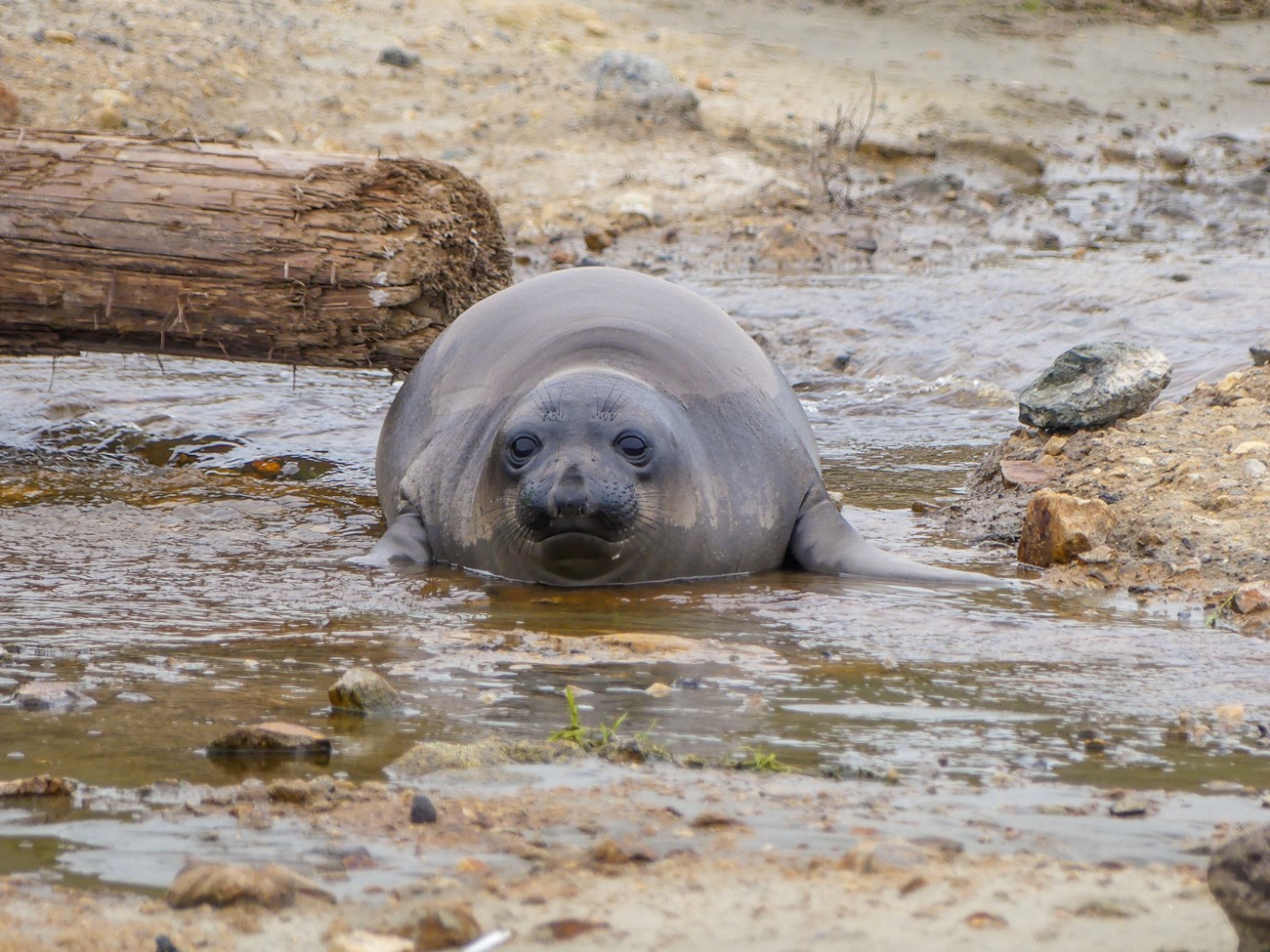
NPS / PRNSA / Aiko Goldston - NMFS Permit No. 27424
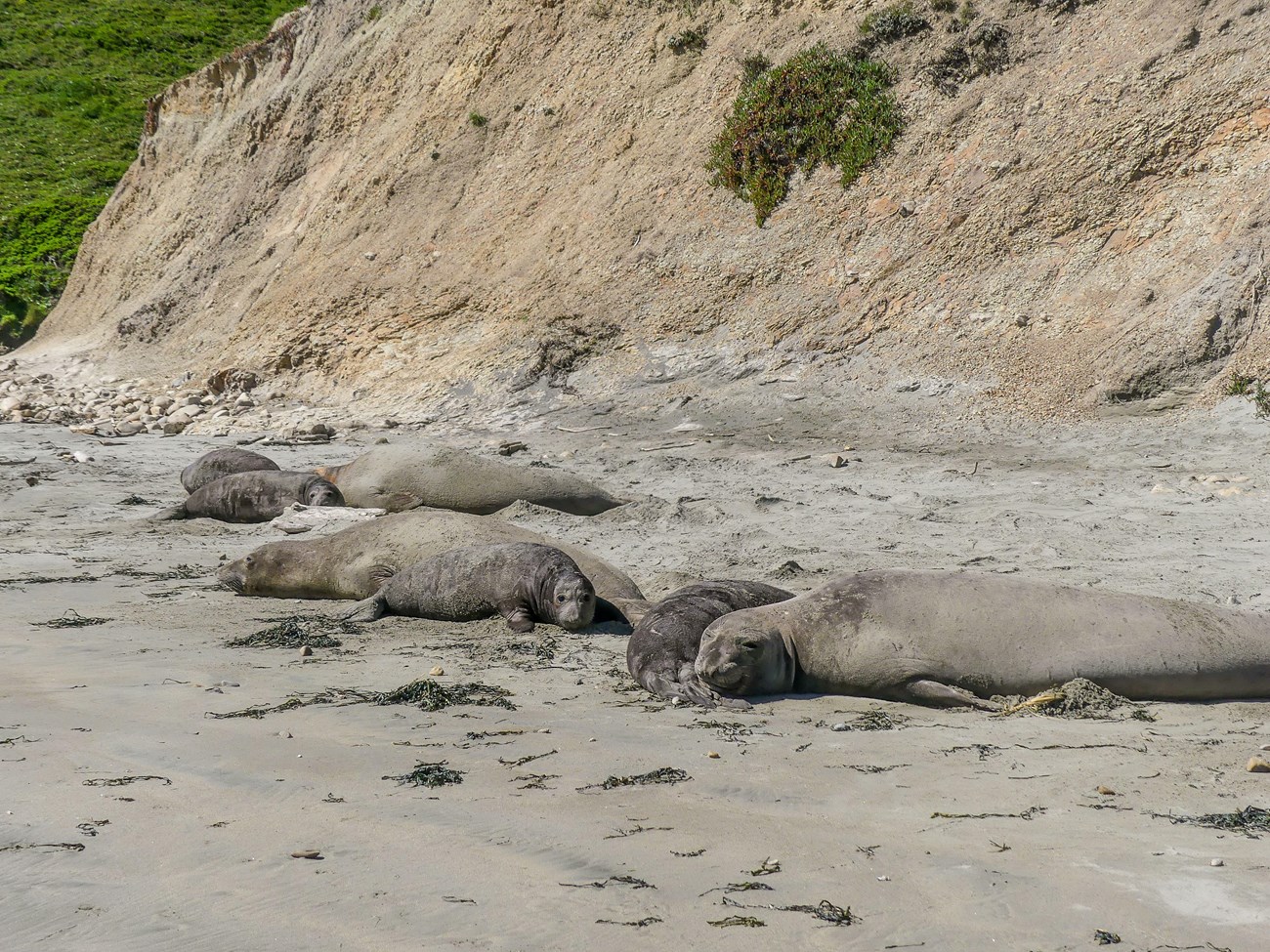
NPS / PRNSA / Aiko Goldston - NMFS Permit No. 27424
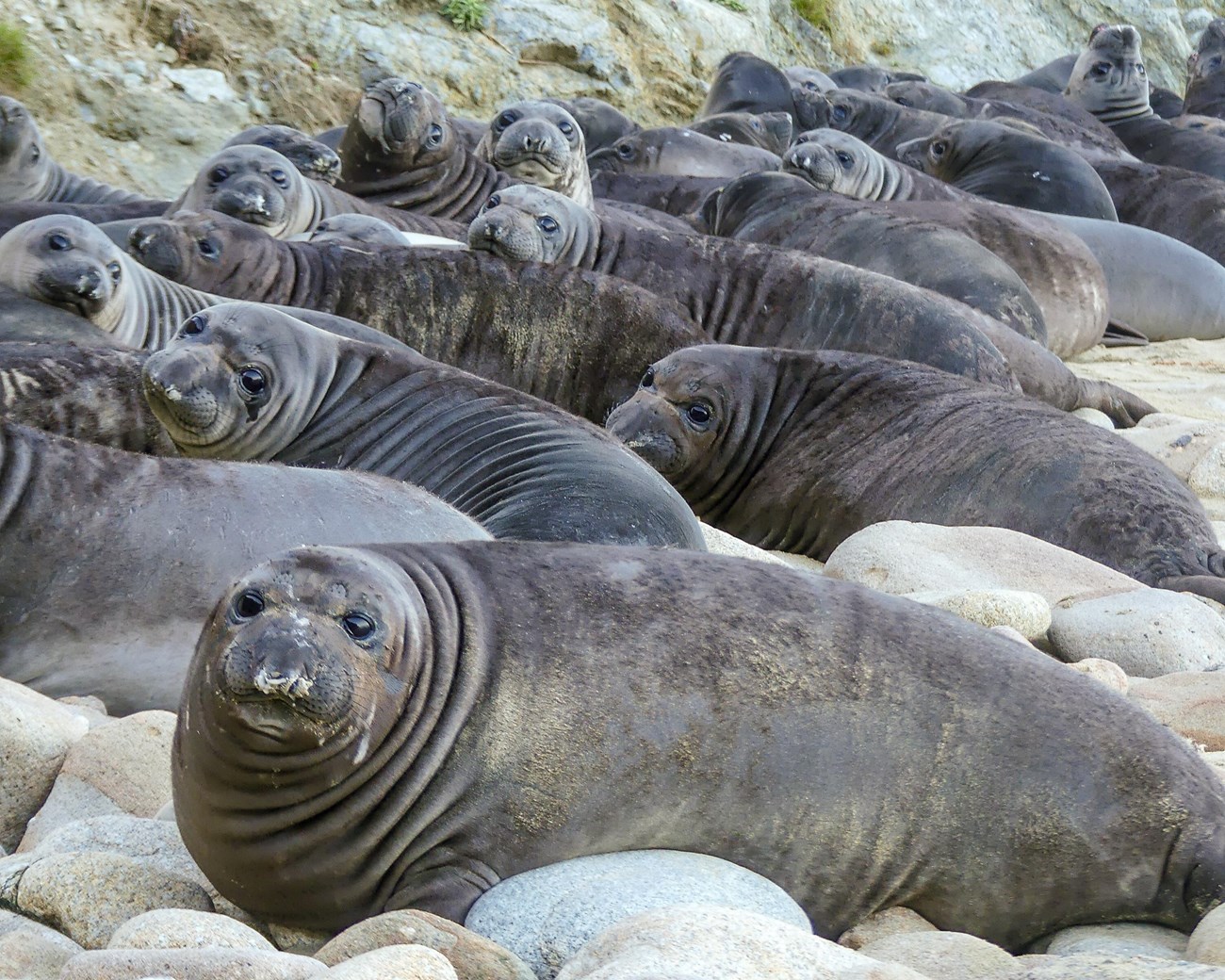
NPS / PRNSA / Aiko Goldston - NMFS Permit No. 27424
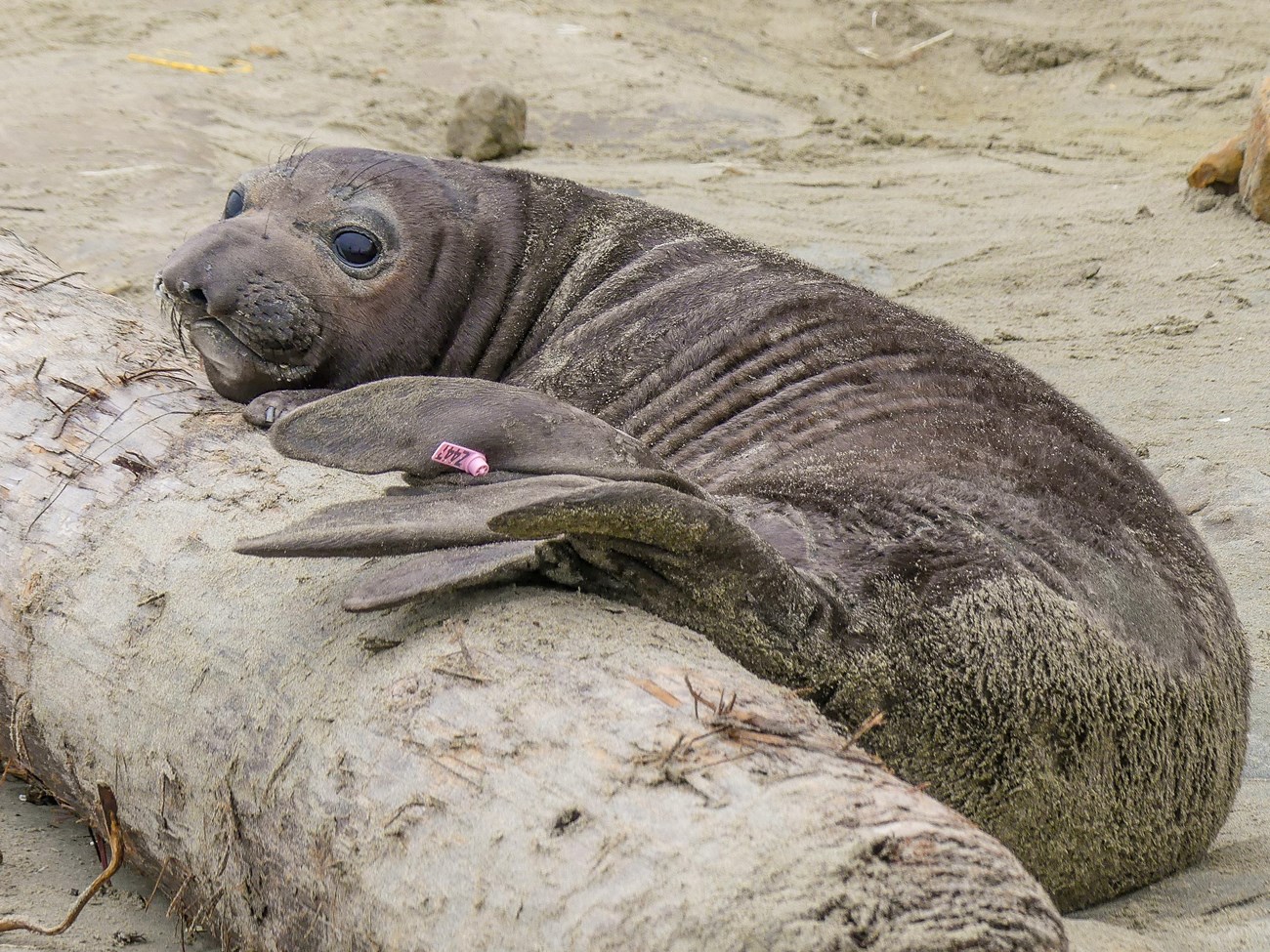
NPS / PRNSA / Aiko Goldston - NMFS Permit No. 27424
What is next for the seals?
And just like that, the elephant seal breeding season is almost over! Beaches that were once packed with cows and pups are now left with only weanlings, males, and the occasional juvenile. This week, biologists counted only 16 cows, down from the max count of 1159 cows on January 27. That means about 99% of cows have weaned their pup, mated, and returned to the open ocean!
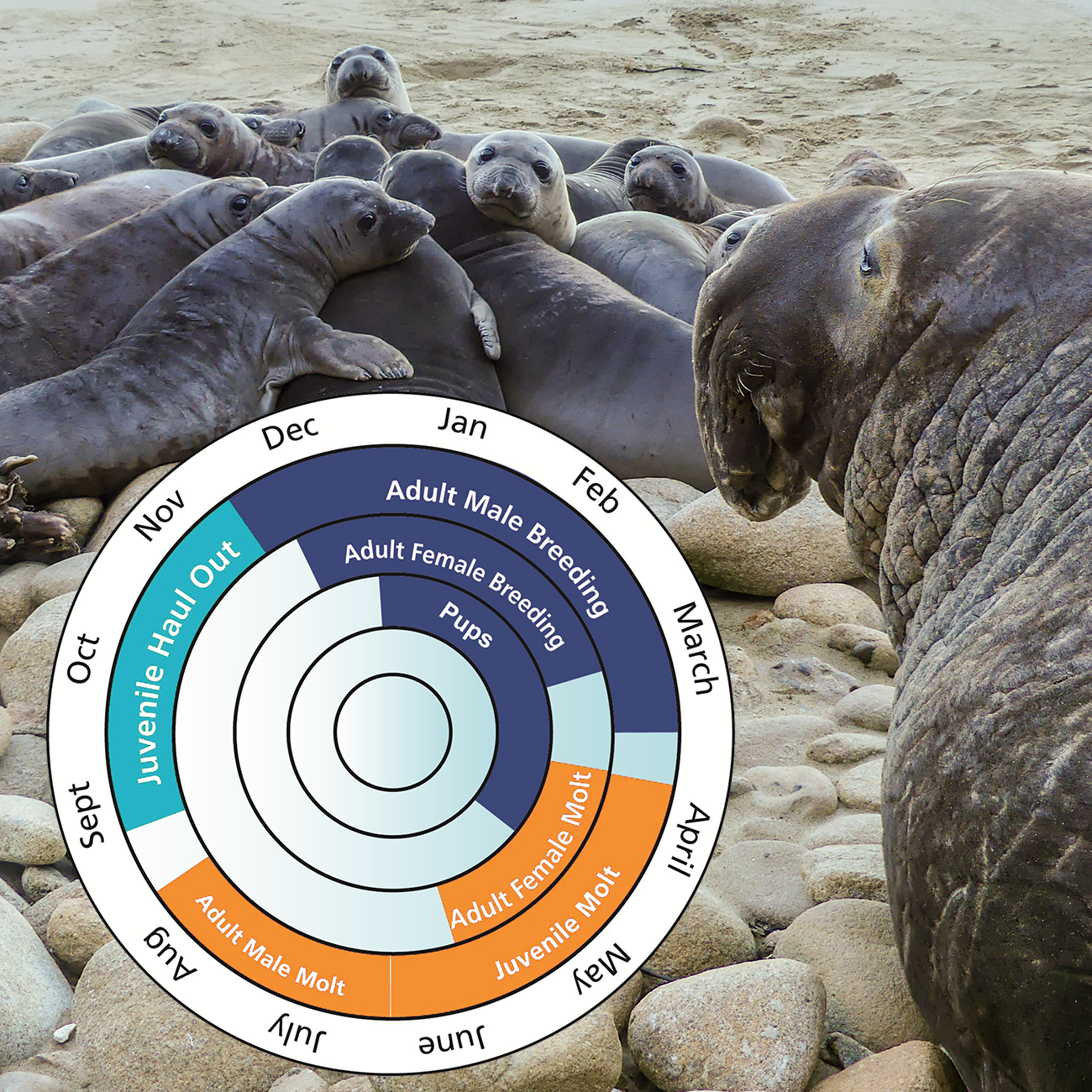
Photo: NPS / PRNSA / Aiko Goldston - NMFS Permit No. 27424
Graphic: NPS
Don’t worry, as elephant seals can be seen almost year-round at Point Reyes. Here is what you can expect in the coming months:
March:
- Males are still on the beach, mating with the last cows. They will head out to sea by the end of the month.
- Weanlings are molting and preparing for their first foraging trip. They will be gone by the end of April.
Late March – June:
- Cows and juvenile seals will return to the beaches to molt.
June – August:
- Males will return to the beaches to molt.
September – November:
- Juveniles, including weanlings from this year, will return to haul out on the beaches.
December:
- Males return to the beaches to begin defending their territories. The arrival of pregnant cows marks the beginning of the new breeding season!
Preliminary Data
Total Elephant Seal Counts, Winter 2024-2025
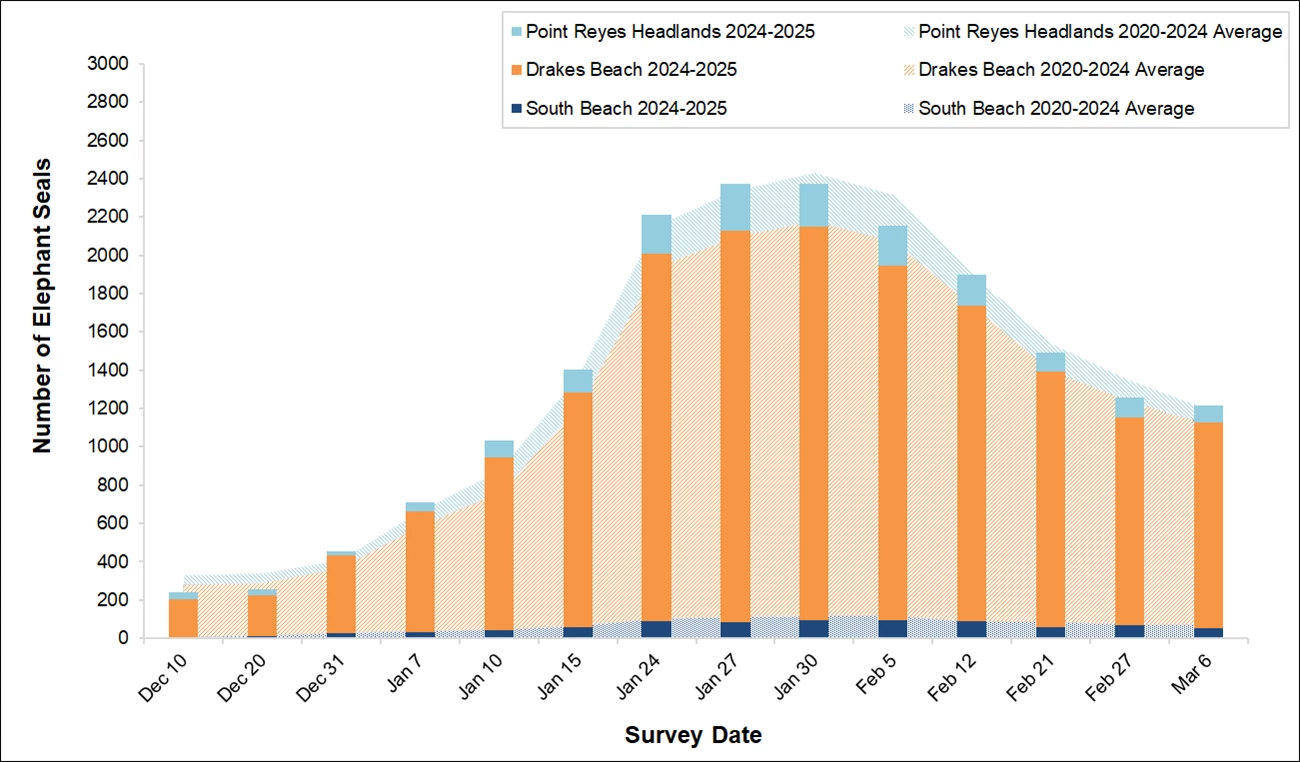
Female Elephant Seal Counts, Winter 2024-2025
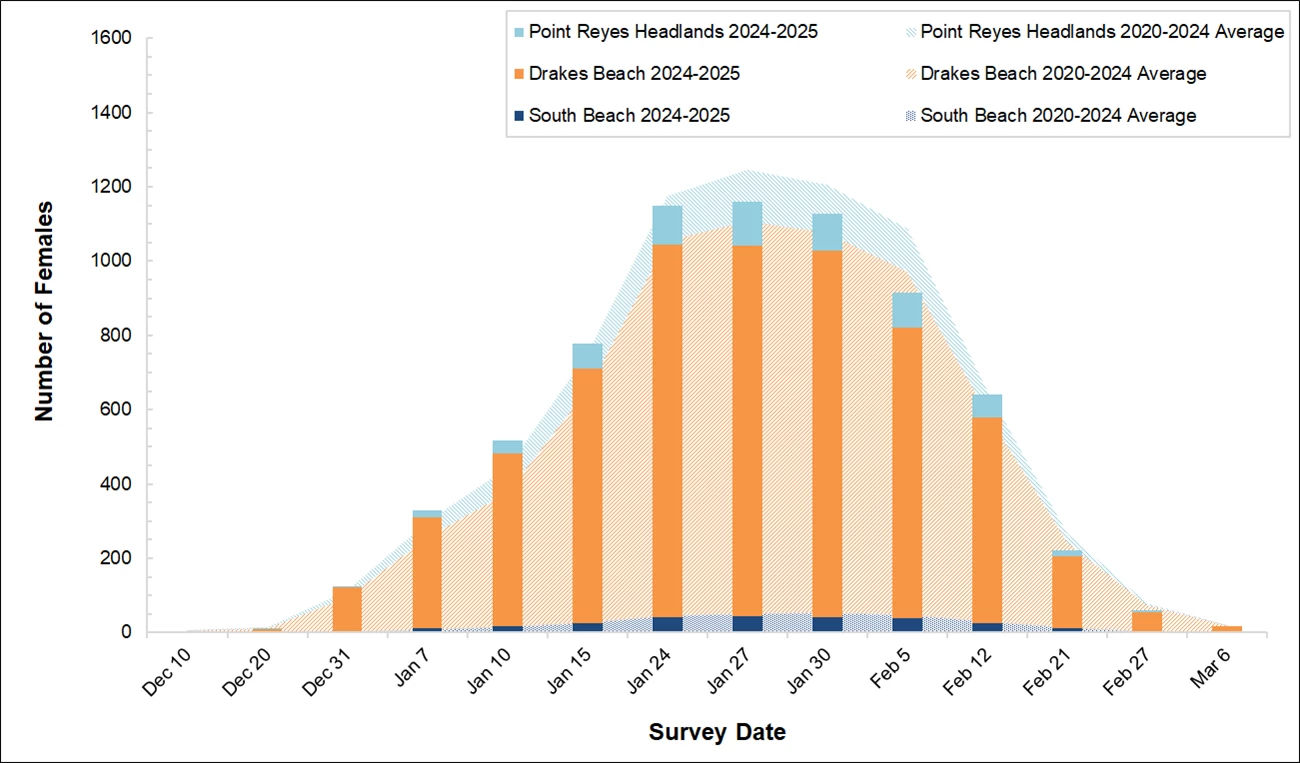
Elephant Seal Pup Counts, Winter 2024-2025
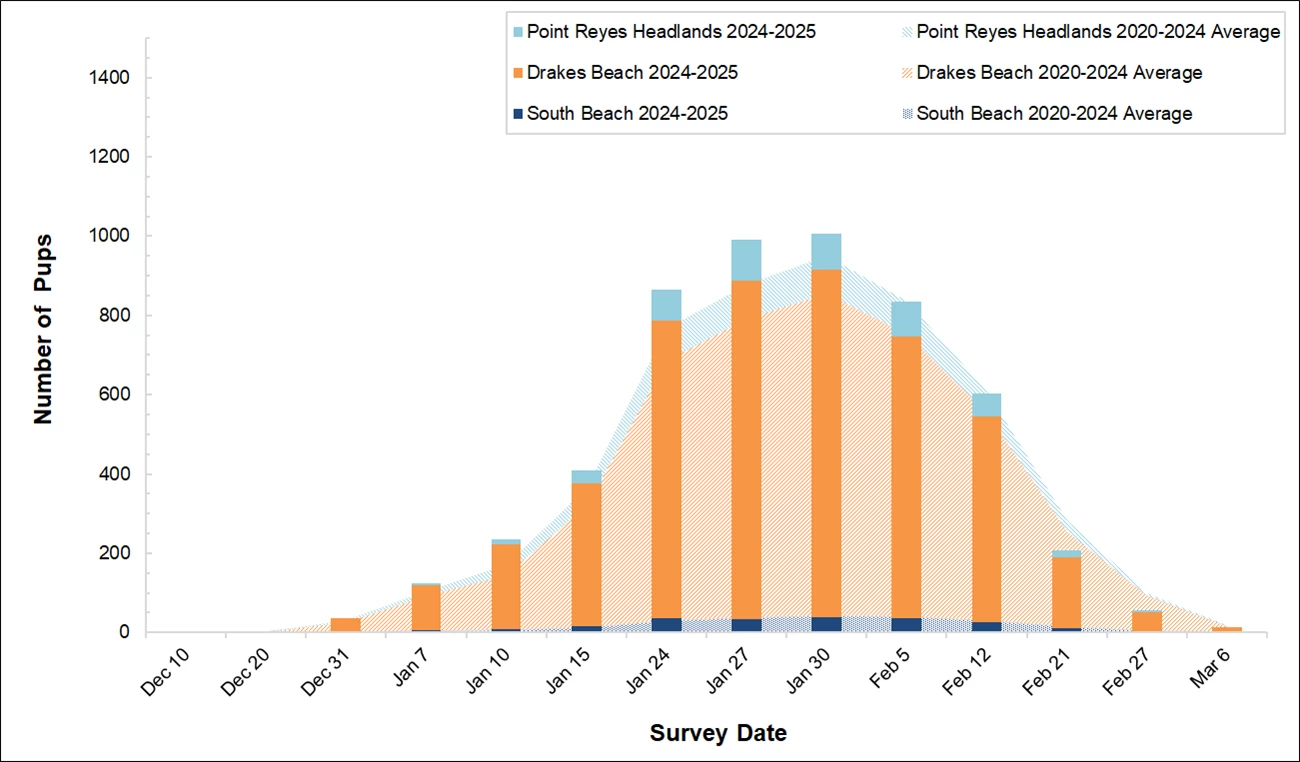
Elephant Seal Weaned Pup Counts, Winter 2024-2025
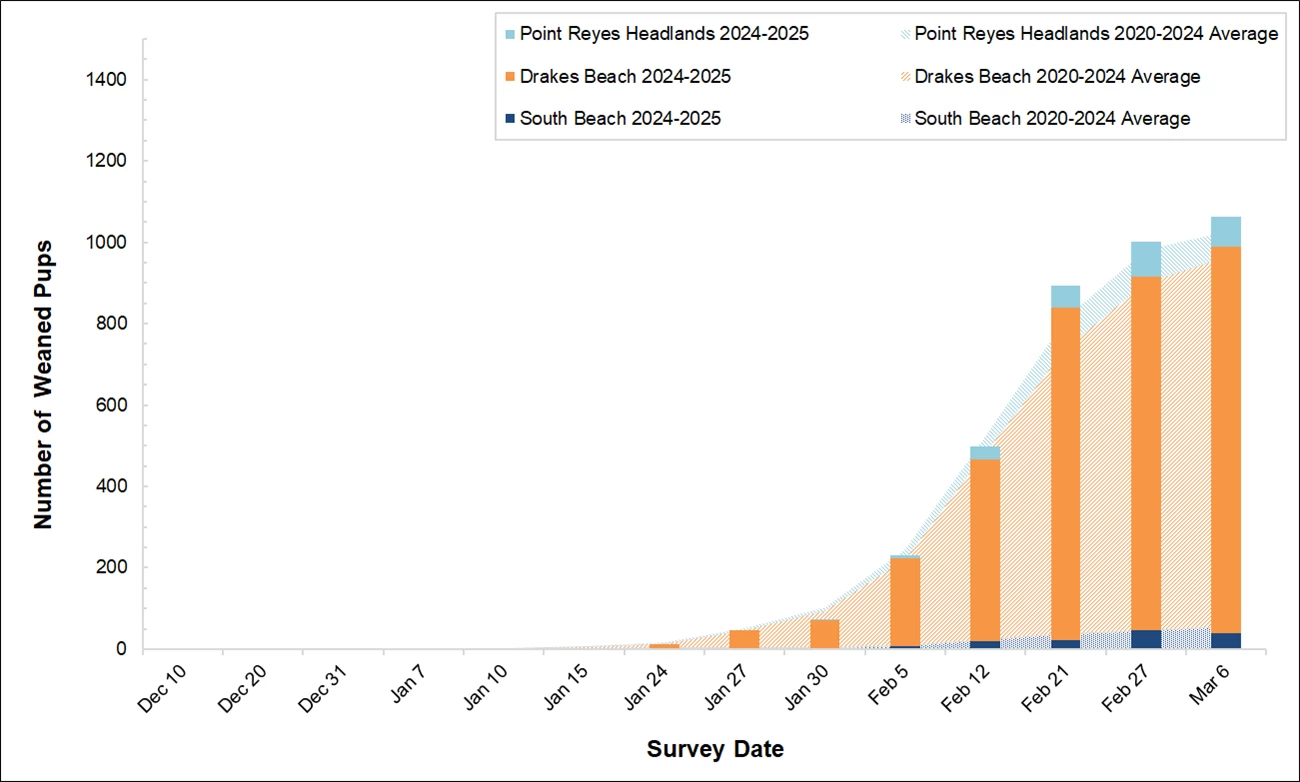
Weekly Updates Recap
News this week
- The first pup of the season was spotted on 12/20. As of 12/31, there are 37 pups!
- Biologists have begun dye-marking adult male elephant seals to track their movement. The ‘V’ prefix denotes seals marked at KPVC. Look out for the current alpha male of KPVC, ‘V1’!
- Most of the seals outside of KPVC are males of all age classes. Males arrive onto the beaches ahead of pregnant cows to claim their territory. We are eagerly awaiting the arrival of a cow!
- Drakes Beach, the Fish Dock, the beach at the Historic Lifeboat Station, and the southern end of South Beach are closed.
Meet the main characters of this season!
Bull (Male)
- What to look for: Large proboscis (nose), pink chest shield.
- Weight: 4400-6000 lbs.
- Length: 12-18 ft.
- Lifespan: 12-14 years
- Yearly Migration Distance: 13,000 miles
Cow (Female)
- What to look for: Absence of a proboscis, narrower snout, often with a pup.
- Weight: ~1,200 lbs.
- Length: 9-10 ft.
- Lifespan: 16-18 years
- Yearly Migration Distance: 12,000 miles
News this week
- As of 1/10, there are seven cows and three pups in front of the Ken Patrick Visitor Center! Docents observed the first pup on the morning of 1/8.
- Due to the birth of the pups, Drakes Beach parking lot will be closed from 4pm – 10am everyday.
- The total count of elephant seals at Point Reyes has been above average so far.
- Drakes Beach, the Fish Dock, the beach at the Historic Lifeboat Station, and the southern end of South Beach are closed.
It's time to go
Elephant seals are quite the punctual marine mammal. Pregnant female elephant seals undertake an approximately 240-day, 6,000-mile migration from their foraging grounds in the open ocean to their breeding grounds. Then, within around five days, they give birth to a pup. Elephant seals do not eat on their migration journey or when they are on the beach, so it is key that they have enough energy reserves to last the next several months. Researchers at UC Santa Cruz used satellite tracking data from cows to determine what factors control their arrival to land. They hypothesized that seals with more energy stores (fatter seals) may return earlier but instead, they found that seals begin their migration journey based solely on where they are and how long it will take for them to get back. The seals seem to have innate ‘map’ and ‘calendar’ information--they found that seals that were farther away from their breeding grounds initiated their return to land at an earlier date. It is still unknown what sensory cues the seals use to keep track of their location and direction.
Works cited: Beltran, Roxanne S. et al. Elephant seals time their long-distance migrations using a map sense. Current Biology, Volume 32, Issue 4, R156 - R157
Foraging strategies
For the short stints of time that they are on land, elephant seals group together and establish social hierarchies. But when they are out in the ocean, they are solitary animals, foraging alone. Male and female elephant seals are very different in size and weight and thus have very different energy requirements. Using satellite-tracking data of seals, researchers found that male and female elephant seals have different foraging strategies to meet their different energy requirements.
Males have a higher energy requirement, as the larger males have higher social rank and reproductive success. Researchers found that males primarily migrate rapidly and directly to their foraging locations along the continental margin, ranging from coastal Oregon to the Aleutian islands. Then, they spend most of the time feeding on dense patches of highly nutritious benthic prey, such as elasmobranchs (sharks and rays) and cyclostomes (lamprey). However, by foraging closer to the coast, male elephant seals have greater exposure to their primary predators, the white shark and killer whale.
Female seals on the other hand, have more variable foraging locations, heading north or west, and remaining in open ocean over deep water. Females appeared to stop and forage opportunistically at many different sites over a larger area. Their movements and diving patterns suggest that they forage on pelagic prey such as cephalopods and lanternfish that migrate up and down in the water column. Because females have a lower energy requirement than males, they can utilize a feeding method that relies on efficiently exploiting smaller food patches. Predation risk is also much lower in the open ocean as white sharks and orcas tend to stick closer to the coast.
Works Cited: Le Boeuf, Burney & Crocker, Daniel & Costa, Daniel & Blackwell, Susanna & Webb, P.M. & Houser, Dorian. (2000). Foraging Ecology of Northern Elephant Seals. Ecological Monographs. 70. 353-382. 10.2307/2657207.
News This Week
- We spotted the first two weanlings on Drakes Beach and the Elephant Seal Overlook this week!
- Pregnant cows continue to arrive on all beaches. We expect their numbers will continue to steadily grow until the end of January.
- Biologists are busy dye-marking bulls around the park. The letter prefix denotes the location we marked them at. Look out for these codes on their hind or side!
- S – South Beach
- F – Fish Dock
- D – Drakes Beach
- V – Ken Patrick Visitor Center
Let me sleep!
At any elephant seal rookery, most seals on the beach will be fast asleep, with only a snort or scratch to show that they are indeed alive! Sleep is a critical function for humans and animals alike, serving as a time for recovery, energy conservation, learning and immune function. Sleeping for a marine mammal is a unique challenge. They feed underwater and breathe at the surface of the ocean where predators typically lurk. Elephant seals must balance foraging, sleeping, and avoiding predators.
To study the sleeping pattern of elephant seals, UC Santa Cruz researchers used sensors to record brain activity and heart rate of diving elephant seals. They found that elephant seals have dives specific for sleeping where they enter different sleep states on the way down. Rapid eye movement (REM) sleep results in paralysis and most marine mammals do not enter this sleep state to remain vigilant for predators. Unexpectedly, elephant seals were found to enter REM sleep for 30% of their total sleeping time in the sea! This REM sleep has a characteristic dive called the ‘sleep spiral’, where the seals turn upside down and drift downward in a spiral. This higher proportion of REM sleep is due to their extreme diving abilities, where they can be deep enough away from predators and risk entering sleep paralysis. Seals foraging near the continental shelf were found to sleep motionless on the ocean floor.
However, even with these sleep adaptations, elephant seals must prioritize almost constant foraging to sustain their large size and energy requirements. The researchers found that seals slept up to 14 hours a day on land but averaged only 2 hours a day at sea for 7 months. This rivals the record for the least sleep among all mammals!
Works cited: Jessica M. Kendall-Bar et al., Brain activity of diving seals reveals short sleep cycles at depth. Science 380, 260-265 (2023). DOI:10.1126/science.adf0566
News This Week
- Elephant seal numbers are rapidly increasing every day, as more pregnant females arrive and give birth. The harem in front of Ken Patrick Visitor Center has 27 cows and 21 pups as of 1/24/25.
- We saw a cow with a pink flipper tag ‘N824’ nursing a pup on Drakes Beach. This seal was tagged as a weanling on South Beach in 2013, making her 12 years old!
- Pups are beginning to wean off their mothers. The current weaned pup count is 13 as of 1/24/25.
Give me a break!
During the last week of nursing, cows will come into estrus and begin mating with males. Elephant seal females have evolved a reproductive strategy called delayed implantation, where a fertilized egg remains in the uterus without developing or dividing. This delay is advantageous for multiple reasons. At the end of the breeding season, cows have lost up to 40% of their body weight; it allows for the cows to return to their foraging grounds and replenish their energy reserves to support a pregnancy. It also allows for them to fast on the beach during the molt without the energetic cost of gestation.
This reproductive adaptation also ensures synchronization of gestation and birth across all the females. While most cows mate around February and March, 15-20% of births are from new mothers or juvenile females who are not on the beach during the breeding season - they breed at varying times. But all cows will return to land to molt in April and May and implantation will occur when they are departing the beach. This means that although there can be variation in breeding timing, the gestation period begins at around the same time for all cows. All cows will be right on schedule to give birth in seven to eight months!
News This Week
- We’ve reached the peak! Biologists counted 2,383 seals on 1/27. On our most recent survey on 1/30 we counted 2,371 seals.
- This season, the peak cow count is below average, but due to calm weather and surf, pup counts are above average.
- Ken Patrick Visitor Center has 29 cows and 29 pups as of 1/30. V1, the alpha male marked at the beginning of the season is holding strong to his harem!
You sound familiar...
Competition is tough for a male elephant seal. From December through March, they are fiercely competing for access to female seals to mate with. Male elephant seals have many behaviors to establish and maintain their social status—vocalizations called “clap threats”, physical posturing, slamming their chests onto the sand to send a seismic signal, and physical fights.
Researchers at UC Santa Cruz used acoustic analysis and playback experiments over four breeding seasons to figure out what information is relayed in these “clap threat” vocalizations. They observed 2,445 male-male interactions and found that these vocalizations are a unique vocal signature for each individual, and males will learn and recognize calls of familiar rivals and respond based on social ranking and previous outcomes of fights. When presented with the calls of a subordinate male, they responded aggressively; when the call of a dominant male was played, they fled without calling.
This communication through vocalizations is an important adaptation that allows for males to conserve their energy and avoid unnecessary fights during their long period of fasting. Researchers found that throughout the season, alpha males competed with an average of 38 other males and physical fights only occurred in less than two percent of the interactions. These fights were always between males of similar social status that had not fought previously that season.
Works cited: Casey C, Charrier I, Mathevon N, Reichmuth C. Rival assessment among northern elephant seals: evidence of associative learning during male-male contests. R Soc Open Sci. 2015 Aug 12;2(8):150228. doi: 10.1098/rsos.150228. PMID: 26361553; PMCID: PMC4555858.
Elephant seal research
This week, park biologists went out with researchers with the Beltran Lab of UC Santa Cruz to collect data on one of their satellite-tagged cows. The researchers measured, weighed, and took samples of the cow for their NSF project: Rules of death across ontogeny in sexually dimorphic mammals. This project aims to determine how male and female body size differences throughout ontogeny (their development) lead to different uses of habitat to maximize ecological rewards and minimize risk. Elephant seals in this study are sampled from birth through age four.
Read more about the Beltran Lab and their research.
News this week
- Total seal and cow counts are below average, while pup counts are similar to the average.
- The seals seemed to have weathered the atmospheric river on Tuesday; there appeared to be little pup mortality based on the count on 2/5.
- Ken Patrick Visitor Center has 33 cows, 27 pups and 3 weaned pups as of 2/5.
- Biologists have began tagging weaned pups with a small tag on their rear flippers. A total of 230 weaned pups were counted on 2/5.
Swim practice
After about 28 days, an elephant seal pup weans from its mother, and it is on its own to learn how to swim and dive in preparation for their first trip out to sea. An average of 60% of weanlings survive their first 4-month journey to the sea. Weanlings don’t leave the beach for about 8–10-weeks– a period termed the ‘postweaning fast’. This is a critical time for the weanlings to develop their swimming, diving and breath-holding. They can often be seen practicing in shallow bodies of water, such as tide pools and protected coves. During this time frame, they are also undergoing physiological changes to aid in their deep dives:
- Increasing oxygen storage capacity: Blood is the main storage for oxygen in phocid seals, containing 65% of oxygen stores, followed by muscle (30%) and lungs (5%). Oxygen stores increase by an average of 47% during the postweaning fast. By the time they are ready to leave the beach, weanlings have amassed almost 75% of the oxygen stores recorded in adult females.
- Decreasing metabolic rate: During the postweaning fast, metabolic rate decreases with increased dive duration and time spent submerged. Over the course of the postweaning fast, the diving metabolic rate of weanlings decreased by about 50%.
Works cited: Thorson PH, Le Boeuf B, "Developmental aspects of diving in northern elephant seal pups" in Elephant seals: population ecology, behavior, and physiology, Le Boeuf BJ, Laws RM, (University of Berkeley, 1994). Pp 271-289.
News This Week
- Total seal counts are dropping as females wean their pups and head out to sea. The total count is similar to the 5-year average.
- Mating is ramping up, with lots of male activity on the beaches. Ken Patrick Visitor Center had 3 bulls and 4 subadults as of 2/12.
- The last births of the season will be happening in the next few days.
- Weaned pup counts continue to increase. A total of 497 weaned pups were counted on 2/12.
Trying their luck
Only five percent of male seals survive to sexual maturity with less than one percent ever gaining reproductive access to females. Typically, only the largest and most dominant alpha males mate successfully. This doesn’t mean that the younger males won’t attempt mating. Subordinate males employ different strategies to try their luck with mating:
- Sneaker male strategy – a strategy where young males will lurk on the edge of the harem and sneak their way into the harem while the alpha male isn’t paying attention. Unfortunately, this is not usually successful, as females will protest with vocalizations, which alerts the alpha. Often, a raised head from the alpha is enough to scare away the smaller male.
- Skulker male strategy – a strategy where a young male skulks around to different harems at night and attempts to mate. They also can wait in the water to mate with the female as she leaves.
Excuse the snot!
When looking closely at elephant seals, one may notice white snot leaking from its nostrils! This white substance is pulmonary surfactant–essential for breathing in all mammals, including humans. The main function of this surfactant is to decrease the surface tension of lung fluid, thus allowing for gas exchange between the lungs and blood. In elephant seals, this surfactant also acts as an anti-adhesive. Elephant seals experience extreme pressure differentials when diving to depths of up to 3000 feet. This means their lungs are collapsing on the dive down and re-inflating on their return to the surface. Pulmonary surfactant prevents lung tissues from sticking to each other during these dives. So, a seal with lots of surfactant is a healthy seal!
News This Week
- The breeding season is ramping down as evidenced by the steady decline in cows. As of 2/21, the cow count was 222, down from last week’s count of 642.
- As of 2/21, the weaned pup count was 894.
- Ken Patrick Visitor Center has 12 cows, 12 pups, and 26 weaned pups as of 2/21.
- Biologists are working with The Marine Mammal Center to collect samples of weanling poop for research on fecal transplants.
A novel observation
In 2022, while conducting a count survey on Drakes Beach, biologists Sarah Allen and Matt Lau observed an altruistic act by an adult elephant seal that responded to a young pup in distress at Drakes Beach. Altruism is defined as the behavioral assistance of another in need, which reduces the assisting individual's own survival or reproduction. Examples of male altruism in marine mammals is a rare occurrence. Elephant seal males infrequently engage in parental care, as they are focused on mating and defending their harem. Sarah and Matt observed a female elephant seal vocalizing to her young elephant seal pup that was being washed out by the waves. The alpha male of the harem was then observed swimming out to the pup and positioning his body so that he was gently pushing the pup with his body and head, back to shore. Once reunited, the cow vocalized, and the pair moved further up the beach. This effort lasted 20 minutes and the male expended critical energy that could have been conserved or used for mating and harem defense. The reasons for altruistic behavior development remains unknown, but genetic relatedness is thought to play a central role.
Read the full observation.
Reference: Allen, S. G., Lau, M. J., & Codde, S. A. (2024). An observation of potential altruism by a male northern elephant seal (Mirounga angustirostris). Marine Mammal Science, 40(3), e13105.
Be right back!
The number of female elephant seals is steadily dropping as they wean their pup, mate, and return to the sea. Males will have left the beaches by the end of March. However, this is a quick journey, as the seals will be returning to undergo catastrophic molting, an important part of their annual cycle. The female and juvenile elephant seals will be back on the beaches in Point Reyes in late March, April, and May. The males will return in July.
When elephant seals molt, they grow a new layer of skin and fur. This causes their old fur and skin to come off in large patches, hence the term, catastrophic molt.
Elephant seals must return to land to molt because of the heat loss that is experienced while shedding their old coat and regrowing new skin and fur. Blood is circulated to the skin to aid in this regrowth; however, heat is lost to the cold temperatures of the sea, lessening the insulation of the seals. Thus, the seals return to the beach, so they don’t have to expend more energy keeping warm and molting. The molting process takes about a month to complete, and the elephant seals are fasting the entire time.
News This Week
- Most elephant seal cows have left, leaving mostly weaned pups and males on the beaches. A total of 59 cows and 57 nursing pups remain in the Seashore.
- Biologists are busy flipper tagging weanlings at many sites. So far, we have tagged 220 weanlings.
- Weaned pup counts are above average, with a total of 1001 counted on 2/27.
Tag, you're it!
Tagging wild animals is a method in wildlife biology to gather information on both an individual and a population, including movement, behavior, and survival. For elephant seals, small plastic tags are applied to the interdigital webbing of the rear flippers of weaned elephant seal pups. Each tag has a unique alphanumeric code and a color specific to each site. These flipper tags allow biologists at different sites to keep track of the elephant seals’ movement and gain more insight on pup mortality, life expectancy, site fidelity, and reproductive success.
Tag colors are site specific:
- Pink – Point Reyes and Farallon Islands
- Green – Año Nuevo
- White – San Simeon/ Piedras Blancas
- Blue – King Range in the Lost Coast area
Last season, biologists at Point Reyes read and recorded 158 total flipper tags. 116 of these seals had pink tags, meaning they were originally flipper tagged at Point Reyes.
If you see a flipper tag, write down its color and number, or take a picture, and share it with park staff.
Elephant Seal Seasonal Monitoring Updates Home >>
Elephant Seal Colonies and Beach Closures Map >>
The National Park Service shall not be held liable for improper or incorrect use of the data described and/or contained herein. These data and related graphics are not legal documents and are not intended to be used as such. The information contained in these data is dynamic and may change over time. The data are not better than the original sources from which they were derived. It is the responsibility of the data user to use the data appropriately and consistent within the limitations of geospatial data in general and these data in particular. The related graphics are intended to aid the data user in acquiring relevant data; it is not appropriate to use the related graphics as data. The National Park Service gives no warranty, expressed or implied, as to the accuracy, reliability, or completeness of these data. It is strongly recommended that these data are directly acquired from an NPS server and not indirectly through other sources which may have changed the data in some way. Although these data have been processed successfully on computer systems at the National Park Service, no warranty expressed or implied is made regarding the utility of the data on other systems for general or scientific purposes, nor shall the act of distribution constitute any such warranty. This disclaimer applies both to individual use of the data and aggregate use with other data. The National Park Service requests that the data user refrain from publishing these data and related graphics and wait until data is available in official, published reports.
